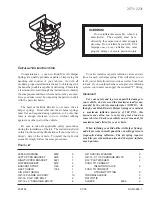
wheels and tyres for damage. Hidden tyre
damage could also be causing the unusual
handling characteristics. If you find no
signs of damage, have the tyres and wheels
checked at a qualified specialist workshop.
R
When parking your vehicle, make sure that
the tyres do not get deformed by the kerb
or other obstacles. If it is necessary to drive
over kerbs, speed humps or similar eleva-
tions, try to do so slowly and at an obtuse
angle. Otherwise, the tyres, particularly the
sidewalls, can get damaged.
Notes on regularly inspecting wheels
and tyres
G
WARNING
Damaged tyres can cause tyre inflation pres-
sure loss. As a result, you could lose control
of your vehicle. There is a risk of accident.
Check the tyres regularly for signs of damage
and replace any damaged tyres immediately.
R
Regularly check the wheels and tyres of
your vehicle for damage (e.g. cuts, punctu-
res, tears, bulges on tyres and deformation,
cracks or severe corrosion on wheels), at
least every 14days, as well as after driving
off-road or on rough roads. Damaged
wheels can cause a loss of tyre pressure.
R
Regularly check the tyre tread depth and
the condition of the tread across the whole
width of the tyre (
Y
page 363). If neces-
sary, turn the front wheels to full lock in
order to inspect the inner side of the tyre
surface.
R
All wheels must have a valve cap to protect
the valve against dirt and moisture. Do not
fit anything onto the valve (such as tyre
pressure monitoring systems) other than
the standard valve cap or other valve caps
approved by Mercedes-Benz for your vehi-
cle.
R
Regularly check the pressure of all the tyres
including the emergency spare wheel or the
spare wheel, particularly prior to long trips,
and correct the pressure as necessary
(
Y
page 365).
Tyre tread
G
WARNING
Insufficient tyre tread will reduce tyre trac-
tion. The tyre is no longer able to dissipate
water. This means that on wet road surfaces,
the risk of aquaplaning increases, in particular
where speed is not adapted to suit the driving
conditions. There is a risk of accident.
If the tyre pressure is too high or too low, tyres
may exhibit different levels of wear at differ-
ent locations on the tyre tread. Thus, you
should regularly check the tread depth and
the condition of the tread across the entire
width of all tyres.
Minimum tyre tread depth for:
R
summer tyres: 3 mm
R
M+S tyres: 4 mm
For safety reasons, replace the tyres before
the legally prescribed limit for the minimum
tyre tread depth is reached..
Notes on selecting, fitting and replac-
ing tyres
R
Only fit tyres and wheels of the same type
and make.
R
Only fit tyres of the correct size onto the
wheels.
R
After fitting new tyres, run them in at mod-
erate speeds for the first 100 km, as they
only reach their full performance after this
distance.
R
Do not drive with tyres which have too little
tread depth, as this significantly reduces
the traction on wet roads (aquaplaning).
R
Replace the tyres after six years at the lat-
est, regardless of wear. This also applies to
the emergency spare wheel/spare wheel.
Operation
363
Wheels
and
tyres
Z
Summary of Contents for E-Class 2011
Page 2: ......
Page 3: ......
Page 5: ......
Page 43: ...40 ...
Page 83: ...80 ...
Page 105: ...102 ...
Page 155: ...152 ...
Page 231: ...228 ...
Page 291: ...288 ...
Page 337: ...334 ...
Page 381: ...378 ...
Page 405: ...402 ...
Page 406: ...403 ...
Page 407: ...404 ...
Page 408: ......
Page 409: ......















































